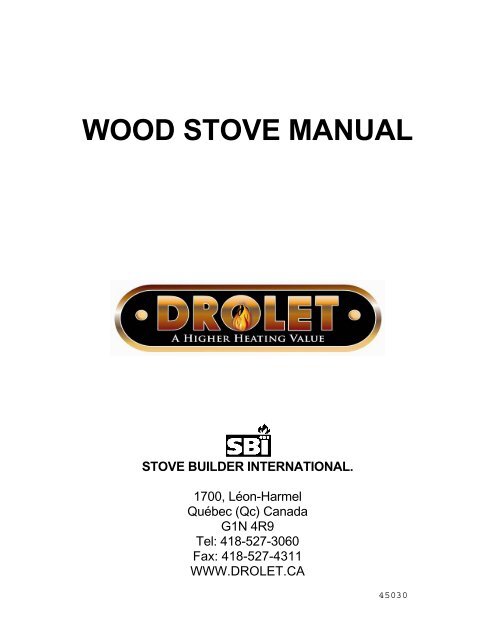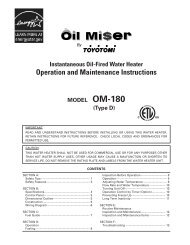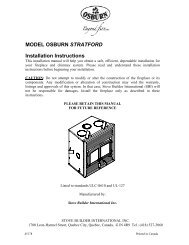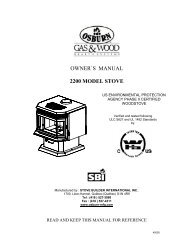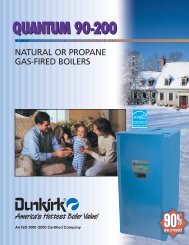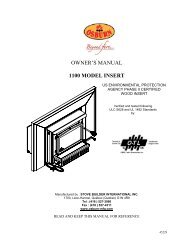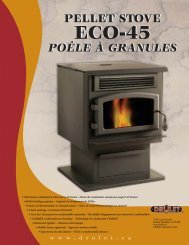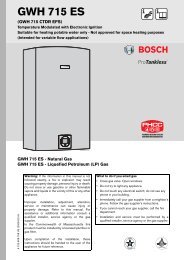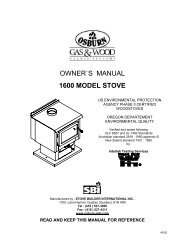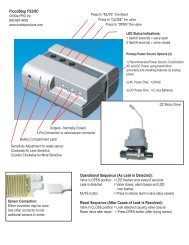Owner's Manual Drolet Nordic Wood Stove - Rural Energy ...
Owner's Manual Drolet Nordic Wood Stove - Rural Energy ...
Owner's Manual Drolet Nordic Wood Stove - Rural Energy ...
Create successful ePaper yourself
Turn your PDF publications into a flip-book with our unique Google optimized e-Paper software.
TABLE OF CONTENTSINTRODUCTION .......................................................................................................................... 3THE DROLET WOOD STOVE MANUAL .................................................................................. 3WOOD HEATING ...................................................................................................................... 3THE CONTROLLED COMBUSTION WOOD STOVE ........................................................... 3ASSEMBLING THE STOVE ..................................................................................................... 4INSTALLING THE FIREBRICKS ............................................................................................ 5INSTALLATION OF YOUR DROLET WOOD STOVE .......................................................... 6POSITIONING THE STOVE .................................................................................................. 6FLOOR PROTECTION .......................................................................................................... 6CLEARANCES TO COMBUSTIBLE MATERIALS ................................................................ 7REDUCED CLEARANCES .................................................................................................... 8STEP BY STEP INSTALLATION OF YOUR CHIMNEY ...................................................... 12COUPLINGS ......................................................................................................................... 19AIR CIRCULATION SYSTEM ............................................................................................... 21BAFFLE BRICK INSTALLATION (SAWMAN STOVE ONLY) .......................................... 21OPERATING YOUR DROLET WOOD STOVE .................................................................... 22FUEL ..................................................................................................................................... 22IGNITION ............................................................................................................................. 23MAINTENANCE OF THE HEATING SYSTEM .................................................................... 25MAINTENANCE OF THE STOVE ....................................................................................... 25MAINTENANCE OF THE CHIMNEY .................................................................................. 26PROCEDURES IN CASE OF FIRE ......................................................................................... 26FREQUENTLY ASKED QUESTIONS ................................................................................... 27WHAT DO THE WORDS “DRAFT” AND “NEGATIVE PRESSURE” MEAN? ................. 27CAN I MODIFY MY STOVE TO INSTALL A GLASS DOOR?............................................. 33WHEN DO IN NEED TO REPLACE THE FIREBRICKS? .................................................. 33DROLET LIMITED LIFETIME WARRANTY .......................................................................... 34REGISTER YOU WARRANTY ONLINETo receive full warranty coverage, you willneed to show evidence of the date youpurchased your stove. Keep your salesinvoice. We also recommend that you registeryour warranty online atwww.drolet.caRegistering your warranty online will help ustrack rapidly the information we need on yourinsert.2
INTRODUCTIONTHE DROLET WOOD STOVE MANUALSBI INC., one of the most important wood stove and fireplace manufacturers in North America,congratulates you on your purchase and wishes to help you get maximum satisfaction from the wood stoveyou have selected. In the pages that follow, we will give you advices on wood heating and controlledcombustion as well as technical specifications regarding installation, operation and maintenance of themodel you have chosen.The instructions pertaining to the installation of your wood stove comply with ULC #S627 standards. Youmust follow them very carefully in order to eliminate any chance of encountering major problems.Read this entire manual before you install and use your new stove. If this stove isnot properly installed, a house fire may result. To reduce the risk of fire, follow theinstallation instructions. Failure to follow instructions may result in propertydamage, bodily injury or even death.PLEASE CONSULT LOCAL AUTHORITIES, BUILDING DEPARTMENT ORFIRE MARSHALL ABOUT RESTRICTIONS, INSTALLATIONREQUIREMENTS AND FOR THE NEED TO OBTAIN A PERMIT BEFOREYOU INSTALL YOUR WOOD STOVE.KEEP THIS INSTRUCTION MANUAL FOR FUTURE REFERENCE.WOOD HEATINGMany consumers choose wood as the main or auxiliary energy source for heating their dwelling orsecondary residence. This source of energy has the advantage of being abundant, relatively cheap andeasy to store so that you are assured of energy autonomy for more of less longer periods.THE CONTROLLED COMBUSTION WOOD STOVEThe main feature of a controlled combustion wood stove is an air tightness that is the most perfect possible,and must of course be equipped with the most efficient heat exchanger possible in order to transfermaximum heat to the ambient air. It is generally doubled with firebricks, and it may have a glass door, withsteel or cast iron frame. The main feature that makes it a controlled combustion wood stove remains its airtightness, which allows the user to control the quantity of oxygen admitted into the wood stove.The wood will burn slowly if the wood stove draught keys are adjusted in order to reduce the oxygen supplyin the combustion chamber to minimum; on the other hand, wood will burn quickly if the draught keys areadjusted to admit a larger quantity of oxygen in the combustion chamber.3
ASSEMBLING THE STOVENote: This section applies to models Compak, ML, RC and <strong>Nordic</strong> only.1- Mount the 4 legs using 2 screws per leg. 2- Mount the ash lip with two screws.3- Install the heat shield between the front legs,just above the leg supports.4- Bend the heat shield slightly to make it fitbetween the back legs.4
INSTALLING THE FIREBRICKSNote: This section applies to models Compak, ML, RC and <strong>Nordic</strong> only.5
INSTALLATION OF YOUR DROLET WOOD STOVEPOSITIONING THE STOVEIt is very important to position the wood stove as close as possible to the chimney, and in an area that willfavor the most efficient heat distribution possible throughout the house. The stove must therefore beinstalled in the room where the most time is spent, and in the most spacious room possible. Recall thatwood stoves produce radiating heat, the heat we feel when we are close to a wood stove. A wood stovealso functions by convection, that is through the displacement of hot air accelerated upwards and itsreplacement with cooler air. If necessary, the hot air distribution from the stove may be facilitated by ablower or the installation of floor or wall grids. It is strictly forbidden to install your wood stove in amobile home.Important:A wood stove must never be installed in a hallway or near a staircase, since it may block the way in case offire or fail to respect required clearance. The wood stove must not be hooked up to a hot air distributionsystem since an excessive accumulation of heat may occur.FLOOR PROTECTIONYour woodstove should be placed on a non-combustible surface. Having these minimum specifications.ModelsThickness ofSheetFLOOR PROTECTIONFront Protrusion Side Protrusions Rear ProtrusionBaron 2000sp 1/4" (6mm) 18" (457mm) 8" (203mm) 10" (152mm)Classic 1/4" (6mm) 18" (457mm) 8" (203mm) 8" (203mm)Compak 1/4" (6mm) 18" (457mm) 8" (203mm) 8" (203mm)Contempro 1600 1/4" (6mm) 18" (457mm) 8" (203mm) 8" (203mm)Contempro 2000 1/4" (6mm) 18" (457mm) 8" (203mm) 8" (203mm)Gemini 1200 1/4" (6mm) 18" (457mm) 6" (152mm) 6" (152mm)Gemini 1500 1/4" (6mm) 18" (457mm) 6" (152mm) 6" (152mm)ML 1/4" (6mm) 18" (457mm) 6" (152mm) 6" (152mm)RC 1/4" (6mm) 18" (457mm) 8" (203mm) 8" (203mm)<strong>Nordic</strong> 1/4" (6mm) 18" (457mm) 8" (203mm) 8" (203mm)Sawman 1/4" (6mm) 18" (457mm) 10" (254mm) 10" (254mm)Sawyer 1/4" (6mm) 18" (457mm) 8" (203mm) 10" (254mm)Whistler , DLX 1/4" (6mm) 18" (457mm) 6" (152mm) 6" (152mm)6
CLEARANCES TO COMBUSTIBLE MATERIALSIt is of utmost importance that the clearances to combustible material mentioned on your wood stovecertification plate be scrupulously respected upon installation.CLEARANCESModel Back Wall Side Walls Corners * HeightBaron 2000sp 24" / 610 mm 16" / 406 mm 16" / 406 mm 7' / 2,13 mBaron 2000spwith enveloppe15" / 381 mm 26,5’’ / 673mm 26,5’’ / 673mm 7' / 2,13 mCompak 16" / 406 mm 16" / 406 mm 16" / 406 mm 7' / 2,13 mContempro 1600 12" / 305 mm 24" / 610 mm 15" / 381 mm 7' / 2,13 mContempro 2000 12" / 305 mm 24" / 610 mm 15" / 381 mm 7' / 2,13 mGemini 1200 16" / 406 mm 16" / 406 mm 16" / 406 mm 7' / 2,13 mGemini 1500 16" / 406 mm 16" / 406 mm 16" / 406 mm 7' / 2,13 mML 16" / 406 mm 16" / 406 mm 16" / 406 mm 7' / 2,13 mRC 16" / 406 mm 16" / 406 mm 16" / 406 mm 7' / 2,13 m<strong>Nordic</strong> 16" / 406 mm 16" / 406 mm 16" / 406 mm 7' / 2,13 mSawman 16" / 406 mm 30" / 762 mm 30" / 762 mm 7' / 2,13 mWhistler, DLX 16" / 406 mm 16" / 406 mm 16" / 406 mm 7' / 2,13 mSingle Pipe / Double Single Pipe / Double Single Pipe / DoubleClassic 16" (406mm) / 12" (305mm) 22" (559mm) / 22" (559mm) 11" (279mm) / 11" (279mm) 7' / 2,13 m* Height, from stove base to ceiling.You may decrease these clearances by installing heat radiation shields between the walls or the ceiling andthe stove. These heat radiation shields must be installed permanently, and can include sheet metal, a rigidnon-combustible sheet or a masonry wall. The installation standards of such heat radiation shields are listedon the following page.IT IS STRICTLY FORBIDDEN TO PLACE WOOD WITHIN THE MINIMUM CLEARANCES.7
REDUCED CLEARANCESYou may decrease the clearances by installing heat radiation shields between the walls or theceiling and the stove. These heat radiation shields must be installed permanently, and caninclude sheet metal, a rigid non-combustible sheet or a masonry wall.Clearances of not less than 1" (25 mm) and not more than 3" (76 mm) between the bottom of theshield and the floor and not less than 3" (76 mm) between the top of the shield and the ceilingmust be respected to allow vertical air circulation behind the shield. The shield must extend 20"(500 mm) above the stove top and 18" (450mm) to each side of the stove (see Graphic 1).Following the installation of such a heat radiation shield, the clearances mentioned on the stovecertification plate may be reduced as stated in the following table.TYPE OF PROTECTIONSheet metal, a minimum of 0,024" (0,61mm) spaced out atleast 1" (25mm) by non-combustible spacers (see graphic2).Ceramic tiles, or an equivalent non-combustible material onfire-proof supports spaced out at least 1" (25 mm) by noncombustiblespacers (see graphic 3).Ceramic tiles, or an equivalent non-combustible material onfire-proof supports with a minimum of 0,024" (0,61 mm)sheet metal backing spaced out at least 1" (25 mm) by noncombustiblespacers (see graphic 4)Brick spaced out at least 1" (25 mm) by non-combustiblespacers (see graphic 5)Brick with a minimum of 0,024" (0,61 mm) sheet metalbacking spaced out at least 1" (25 mm) by non-combustiblespacers (see graphic 6).Reducing Clearances WithShieldingSides andTopRear/Back67% 50%50% 33%67% 50%50% N/A67% N/A8
Graphic 1A- Clearance to combustible material with no protection.B- 500 mm (20 po.) minimum;C- 25 mm (1 po.) minimum;D- Between 25 mm (1 po.) and 75 mm (3 po.) ;E- 75 mm (3 po.) minimum;F- 450 mm (18 po.) minimum.1- Wall shielding ;2- Non-combustible spacers ;3- Ceiling shielding ;4- Combustible wall ;5- Ceiling;6- Heater (side view) ;7- Heater (top view).9
Graphic 2A- 25 mm (1 po.) minimum;1- Combustible wall ;2- Non-combustible spacer;3- 0.61 mm (0.024") sheet metal.Graphic 3A- 25 mm (1 po.) minimum;1- Combustible wall;2- Non-combustible spacer;3- Fire-proof support;4- Ceramic tile or equivalent non-combustible material._____________________________________________________________________________A- 25 mm (1 po.) minimum;Graphic 41- Combustible wall;2- Non-combustible spacer;3- 0.61 mm (0.024") sheet metal;4- Fire-proof support;5- Ceramic tile or equivalent non-combustible material.10
Graphic 5A- 25 mm (1 po.) minimum;1- Combustible wall;2- Non-combustible spacer;3- Brick.Graphic 6A- 25 mm (1 po.) minimum;1- Combustible wall;2- Non-combustible spacer;3- 0.61 mm (0.024") sheet metal;4- BrickFOR BARON 2000SP USING THE ENVELOPEIt is strictly forbidden to connect the envelope to existing liners or existing floor registersor grilles.11
CHIMNEYYour wood stove may be hooked up with a prefabricated or masonry chimney. If you are using a prefabchimney, it must comply with S-629 standards; therefore it must be approved for up to 2100 o F (650° C). It isextremely important that it be installed according to the manufacturer's specifications.If you are using a masonry chimney, it is important that it be built in compliance with the specifications of theNational Building Code. It must be lined with refractory bricks, metal or clay tiles sealed together with firecement. (Round flues are the most efficient).The interior diameter of the chimney flue must be identical to that of the stove smoke exhaust. A flue whichis too small may cause draft problems, while a large flue favors rapid cooling of the gas, thus enhancingcreosote build-up and the risk of chimney fires. Current practice requires that the area of the chimney fluedo not exceed the stove exhaust area by more than 35%. For a round pipe, 35% of the area representapproximately 1” (25 mm) on the diameter. (ex: For a stove with an exhaust of 6”, the chimney flue shouldnot exceed 7” of diameter.) Note that it is the chimney and not the stove which creates the draft effect; yourstove's performance is directly dependent on an adequate draft from your chimney.The following recommendations may be useful for the installation of your chimney:1) It must rise above the roof at least 3' (0,9 m) from the uppermost point of contact.2) The chimney must exceed any part of the building or other obstruction within a 10' (3,04 m) distanceby a height of 2' (0,60 m).3) Installation of an interior chimney is always preferable to an exterior chimney. Indeed, the interiorchimney will by definition be hotter than an exterior chimney, being heated up by the ambient air inthe house. Therefore the gases which circulate will cool more slowly thus reducing the build-up ofcreosote and the risk of chimney fires.The draft, which is created by the tendency for hot air to rise, will be better with an interior chimney.4) You must not install more than one heating unit per chimney flue.5) The use of a fire-screen at the extremity of the chimney requires regular inspection in order toinsure that it is not obstructed.STEP BY STEP INSTALLATION OF YOUR CHIMNEYNote : The way to install your chimney may vary from one chimney manufacturer to another. Theinstructions contained in this manual are based on the recommendations of chimney manufacturers whoseproducts are sold at many Canadian retailers of wood stoves and related heating accessories.WALL SUPPORT SYSTEMIf your chimney must rise along an outside wall, you need to connect it to your stove through an adjacentwall. For this type of installation, the following items are normally required :Chimney• Suitable lengths of chimney (enough to go up to your roof)• An adjustable wall support• A wall thimble• An adequate number of wall bands (one for every 8 feet of chimney, excluding the roof portion)• A stove pipe adapter• One insulated tee & plug• A chimney cap.• Roof guys (if required)12
<strong>Stove</strong> pipe• An adequate number of stove pipe sections.• A 90 o elbow1- Start by positioning your stove where you would like it to go, taking into account the minimumclearances to combustible material. You will then be able to determine where the chimney will passthrough the wall. You will probably have to adjust the stove position slightly to ensure that yourchimney will run between the studs. You can use a stud finder to locate the studs. Use a spoke sawor jig saw to cut a hole, remembering that you need to maintain a clearance of 2 inches between thechimney and any combustible materials. For concrete walls, cut a hole slightly larger than the outerdiameter of the chimney.2- Once the opening completed, you need to frame in the area to allow for the installation of a wallthimble. A wall thimble is not required for installations through concrete walls.3- You must first secure the wall thimble into the exterior wall surface. Then, do the same inside andfasten the trim plate.13
4- Then, from outside the building, slide a short chimney length (attached to the tee) through the wallthimble. The chimney must extend at least 3 inches into the living space where it attaches to thestove pipe.5- You can now install the wall support. Simply slide the wall support up to the tee, ensuring that theadapter on the support engages with the female coupler on the bottom of the tee. When the wallsupport is level and properly positioned, you can use lag bolts to secure it into the wall studs. TOcomplete the installation, install an insulated tee plug below the wall support.6- You can start to add chimney sections. We recommend that you also use locking bands to secureall connections. You will need to secure the chimney to the house using wall bands. Wall bandswrap around the chimney and then attach to the wall. Install the first one 3 feet above the wallsupport. Then, you will need another band for each 8 feet of chimney. Note: if your chimneymust be installed through your soffit, install a roof flashing above and finishing plate belowwhere the roof is cut. Consult the following section called “CEILING SUPPORT SYSTEM” formore details.14
<strong>Stove</strong> pipe• Suitable lengths of stove pipe1- Place your stove where you would like it located and use a plumb line to mark the ceiling directlyabove your stove flue. You will probably have to adjust this position slightly to ensure that yourchimney will run between the joists. You can use a stud finder to locate the joists. You also need totake into account the minimum clearances to combustible materials. After you have determinedwhere the chimney will go through the ceiling, use a spoke saw or power jig saw to cut a hole,remembering that you need a minimum 2-inch clearance between the chimney and any combustiblematerials. Depending on whether you have a one or two story structure, you will need to cut amatching hole through the floor of the attic or second floor living space.2- Before you install the ceiling support, you need to frame the area.3- To install the ceiling support, just slide the assembly into the framed opening from below. Once youensure that the finishing plate is flush with the underside of the ceiling and assembly is level, secureit with screws.16
4- Once the support is secure, you can begin to assemble the chimney by lowering the first section intothe support. Make sure that the male coupler is pointing upwards, as indicated by the arrow on thechimney label.5- Then, from beneath the support, insert the stove pipe adapter and twist-lock it into place.6- Now, you can add additional chimney sections. Continue adding chimney lengths until a height ofabout 2 fet below the next ceiling level. An attic insulation shield must be installed where a chimneypasses from a lower living space into an upper living space or attic space. It is designed to keepinsulation materials away from the chimney. A second attic insulation shield must be installed ifyour chimney passes from a lower living space into an upper living space. As wee, you mustenclose all sections of the chimney where is passes through a living space. Elbows (15 o or 30 o) areused when you need to offset your chimney to clear an obstruction or to avoid having to cut joists.7- Once you have cut through your roof and framed the joists, it is time to work outdoors. Authoritiesrequire that the chimney extend not less than 3 feet above the highest point where it passes throughthe roof of a building and not less that 2 feet above any portion of the building within 10 feet. You willneed to install a roof flashing. The roof flashing slides over your chimney pipe and goes under yourshingles. Once you have done that, check that everything is plumb, and nail the flashing into theroof deck. Seal the joint between the shingles and the plate with silicone.17
8- Next, slide the storm collar down the chimney until it contacts the flashing. Tighten the nut and boltand seal the collar to the chimney with a waterproof, non-combustible silicone sealant. Finally, twiston your rain cap and you can head back inside. If the chimney extends more than 5 feet above theroof deck, roof guys with telescoping legs and draw bands are required.9- You are now ready to connect your chimney to your stove. Simply install the inter-connecting stovepipe between the stove pipe adapter and the stove. You can follow the instructions in the followingsections of this manual under “COUPLINGS”.18
COUPLINGSIt is very important to measure the clearance between your connectors (commonly called stove pipe) andthe surrounding combustible surfaces. If the normal 18 inches clearance required cannot be obtained, youmay have to use an insulated flue pipe in order to install. You must read the flue pipe manufacturer'sinstructions before installation.Your connectors and chimney must have the same diameter as the stove outlet. If this is not the case, werecommend you contact your supplier in order to insure there will be no problem with the draft. Yourconnectors should be made of aluminized or ordinary steel with a minimum 24 gauge thickness.Your smoke exhaust system (connectors) should be assembled in such a way that the male section of thepipes faces down. Attach each of the sections to one another with three equidistant metal screws.The connectors must be short and straight. All sections installed horizontally must slope at least 1/4 inch perfoot, with the upper end of the section toward the chimney.To insure a good draft, the total length of the exhaust system should never exceed 8 to 10 feet. (Except forcases of vertical installations or cathedral-roof, where the smoke exhaust system can be much longer andconnected without problem to the chimney at the ceiling level). There should never be more than one 90°elbow in the smoke exhaust system.Installation of a "barometric draft stabilizer" (fireplace register) on a smoke exhaust system is notrecommended.Furthermore, installation of a draught damper is forbidden. Indeed, with a controlled combustion woodstove, the draught is regulated upon intake of the combustion air in the stove and not at the exhaust.The connectors must not go through a ceiling, a storage area, a floor, or any other combustible partition.19
Avoid 90 degree eblowsWe recommend that you usetwo 45 degree elbows instead20
AIR CIRCULATION SYSTEMIn order to improve air circulation in the room where the wood stove is installed, certain options are availablefor specific stove models.Blower:A variable speed-control blower is available. Please note that there are two types of blowersavailable, depending on the stove model you have. If the hole at the back of your stove(where the blower needs to be hooked-up) has a round outlet, you will need blower#AC05520. If there is a rectangular knock-off, you will need blower #AC02050.Thermodisc: Available on most models, the thermodisc is a sensor that connects to the blower`selectrical supply cord, and it will start the blower when the stove`s temperature reaches120° F (49 o C) and cut off power when the stove cools down below 100° F (37 o C).Information regarding installation of the thermodisc is included with the device.The blower system includes some particularities for specific stove models: For the Compak,CS1200, Little Sawman, ML, <strong>Nordic</strong> and RC, an adaptor is required in order to install theblower. That adaptor is included with the stove, when purchased.BAFFLE BRICK INSTALLATION (SAWMAN STOVE ONLY)- The Sawman C-Cast baffle is shipped with the stove. However, in order to avoid shipping damages,it is not installed on the stove. You need to install it by following the instructions on the drawingbelow.- Please note that heating the stove without the C-Cast baffle can seriously damage the firebox andwill automatically nullify your warranty. The C-Cast baffle will eventually need to be replaced. Howlong it will take depends on how often you use your stove. It is very important that you do notpostpone the replacement of the C-Cast baffle when you see that it starts to disintegrate.21
OPERATING YOUR DROLET WOOD STOVEFUELYour stove was designed to burn wood only. No other type of fuel should be used. Waste and otherflammable materials are prohibited. Any type of wood may be used in your stove, but specific varieties havebetter energy yields than others. Please consult the following table in order to make the best possiblechoice.AVERAGE ENERGY YIELD OF ONE AIR DRIED CORD OF CUT WOODHigh <strong>Energy</strong> YieldMBTU/cord MBTU/cord MBTU/cordOak 29 Sugar Maple 28 Beech 26Medium <strong>Energy</strong> YieldMBTU/cord MBTU/cord MBTU/cordYellow birch 25 Ash 24 Elm 23Larch (Tamarack) 23 Red Maple 23 Douglas red fir 23Silver birch 22Low <strong>Energy</strong> YieldMBTU/cord MBTU/cord MBTU/cordAlder 18 Poplar 17 Hemlock 17Spruce 17 Pine 17 Bass 16Fir 13Data provided by <strong>Energy</strong>, Mines and Resources - CanadaIt is EXTREMELY IMPORTANT that you only use DRY WOOD in your wood stove. The wood must havedried for 9 to 15 months, so that the humidity content is reduced below 20% of the weight of the log. It isvery important to keep in mind that even if the wood has been cut for one, two or even more years, it is notnecessarily dry, especially if it has been stored in poor conditions. Under extreme conditions, it may evenhave rotten instead of drying. This point cannot be overstressed enough; the vast majority of the problemsrelated to the operation of a wood stove is caused by the fact that the wood used was too damp or had driedin poor conditions. These problems can be:- Ignition problems.- Creosote build-up causing chimney fires.- Low energy yield.- Blackened glass door.- Incomplete log combustion.- Etc.22
Smaller pieces of wood will dry faster. All logs exceeding 6" (152 mm) should be split. The wood should bestored in a place where the grass is not too long, in such a way that prevailing winds may circulate throughthe fire logs. A 24" to 48" (610 mm to 1219 mm) air space should be left between each row of fire logs,which should be placed in the sunniest location possible. If the wood must be stored outside, the upperlayer of wood should be protected from rain and bad weather but not the sides.Before your first fire:- Check if firebricks are lined-up properly.- If applicable, remove the plastic protector covering the gold trims.- Make sure that the chimney and flue pipe are well installed according to specifications.- Respect all clearances to combustibles and floor protection according to the unit you have chosen.- If you are not sure that your installation is adequate, do not hesitate to contact your <strong>Drolet</strong> dealer.IGNITIONThe installation of a log cradle is NOT RECOMMENDED in your DROLET wood stove.After making sure that the stove air intake controls are fully open, place several rumpled sheets of paper atthe center of the firebox. Place 8 to 10 pieces of small dry kindling wood over the paper in the form of a tent.You may also place a few pieces of firewood, but choose them as small as possible. No chemical product(or accelerant) should be used to light the fire.Before igniting the paper and kindling wood, it is recommended that you warm up the chimney. This is donein order to avoid backdraft problems often due to negative pressure in the house; cold air from the outsidetends to penetrate into the house by the chimney and creates a “clog” effect.If such is the case, open a window slightly near the stove and twist together a few sheets of newspaper intoa torch. Light up this paper torch and hold it as close as possible to the mouth of the pipe inside the fireboxto warm up the chimney. Once the updraft movement is initiated, you are ready to ignite the stove bylighting the paper and kindling wood inside the combustion chamber.We advise you to leave the door slightly open (a few inches) for a 5 to 10 minutes period, under supervision,in order to allow for good combustion. After this time, you may close the door and progressively adjust theair controls to obtain the desired temperature.CAUTION:- Do not leave the stove unattended when the door is slightly open.- When the stove is used for the first time, intense fire is prohibited in order to allow adequate curingof the paint covering the stove and to prevent a "thermal shock" which may remove or whiten thepaint.- Make sure the room is well ventilated, to remove the bad odors emitted from the paint, during thefirst two or three hours of usage.- Never heat the stove outside the house before you install it. It is impossible to adequately monitorthe combustion intensity, which may cause overheating and a thermal shock to the paint.- Never use fluid or chemical products to ignite the fire.- Do not burn wastes, flammable fluid such as gasoline, naphtha or motor oil.23
HEATINGOnce you have obtained a good bed of embers you should reload the unit. In order to do so, open the aircontrol completely for a few seconds prior to opening the stove door. Then, proceed by opening the doorvery slowly. Open it by one or two inches for 5 to 10 seconds before opening it completely. This will increasethe draft and will eliminate the smoke, which is stagnant in a state of slow combustion. Then, bring the redembers to the front of the stove and reload the unit. Use only the quantity of wood required depending onthe circumstances; for example, in severe cold weather, load the stove to maximum. During mildertemperatures, the stove should be only half loaded. CAUTION : DO NOT PLACE LOGS TOO CLOSE TOTHE GLASS OR THE DOOR. IF LOGS ARE TOO CLOSE TO THE GLASS OR THE DOOR, THEY MAYFALL WHEN YOU OPEN THE DOOR. FURTHERMORE, THE LOGS THAT ARE TOO CLOSE MAYDAMAGE THE GLASS IF YOU SHUT THE DOOR TO HARD.When possible, we recommend that you operate the stove with a wood load approximately equivalent to theheight of the fire bricks. If you constantly load the stove above the fire bricks, you may damage the fireboxand cause the paint to whiten.It is extremely important that you use your stove in such a way that you do not lower the temperature of thecombustion gases inside the chimney too much. For this purpose, we strongly recommend that you install a<strong>Drolet</strong> chimney thermometer on your exhaust pipe, approximately 18" above the stove. Contact your <strong>Drolet</strong>dealer in order to buy one. This thermometer will indicate the temperature of your exhaust gases inside theexhaust system. The ideal temperature range is indicated on the thermometer. If temperature is too low, thebuild-up of creosote is promoted while if temperature is too high, heat is wasted since too large a quantity isemitted into the atmosphere.In summary, it is very easy to operate your wood stove and you can prevent all potential problems byfollowing these recommendations:1) Select a stove of adequate size: selecting a stove that is too big for the area to be heated is acommon mistake;2) Follow the installation standards scrupulously and respect the clearances to combustible material;3) Burn only dried wood, that is, with a maximum 20% humidity content;4) Install a chimney thermometer on your stove pipe, 18" (457 mm) above the stove, and maintain thetemperature of your exhaust gases between 250°F and 475°F.Keep in mind that the most difficult months for wood heating are October and November. Indeed, during thisperiod, the atmosphere is often very heavy and humid, and may hinder the chimney draft. Moreover, thewood is often too damp, since it has not had a sufficient drying period, or it has been stored outside in therain. Combustion problems may then occur.Important:It is important to note that wood combustion consumes ambient oxygen in the room. In the case of negativepressure, it is a good idea to allow for a fresh air intake in the room, either by opening a window slightly or byinstalling a fresh air intake system on an outside wall.24
MAINTENANCE OF THE HEATING SYSTEMMAINTENANCE OF THE STOVEOur wood stoves are designed so that they will require little maintenance:- It is wise to perform a visual inspection of the stove approximately once a month, in order to insure thatno parts have been damaged, in which case repairs must be performed without delay.- If the glass on your stove breaks, you must replace it with one of the same type, namely, a 3\16" (5 mm)thick ceramic glass; never replace the glass with another material.- To replace the glass, remove the screws retaining the window moldings inside the door. Then, removethe moldings and replace the damaged glass with a new one.- Never wash the windows with a product that may scratch it. Use a specialized product, available in thestores where wood stoves are sold.- Windows should be washed only when they are cold.- It is recommend that you change the fiber ceramic gasket that makes the door on your stove airtight.Replacement should take place once a year under normal conditions. This is important to insure goodcontrol over the combustion, maximum efficiency, and security. To change your door gasket, simplyremove the old gasket and carefully clean the door groove. Install the new gasket by carefully followingthe instructions on the gasket packaging. IMPORTANT: different models of <strong>Drolet</strong> wood stovesrequire different types of gasket. You need to buy the original gasket supplied by themanufacturer. Avoid low density gasket, which often comes with liquid glue. Only hightemperature silicone should be used. If you need an original replacement gasket kit, consult yourdealer or visit our web site at www.drolet.ca- You should regularly dispose of the ashes, as soon as they prevent you from placing a normal load oflogs. We recommend that you always leave one to two inches of ashes in the bottom of the stove inorder to insure maximum efficiency.- Always use a metal container with a lid to save the cooled ashes you remove from the stove. Make surethat there are no live embers. Moreover, it is important to place the metal container on a noncombustible surface.- Never bang the door and never hit the glass. When you close the door, make sure the logs are placed insuch a way that they do not lean on the glass. Otherwise, someone could open the stove door and causethe burning logs to fall on the floor.- It is possible to give your wood stove a brand new look by repainting it with a 1200° F (649 o C) heatresistant paint. For this purpose, simply rub the surface with fine sand paper #180. The closer to themetal you go, the tougher the paint coat will be. Clean the stove and apply thin coats of paintsuccessively. Remember that upon ignition of the stove, the new paint will go through a “curing” processand will produce smoke and odors. This is normal. Leave a window open.25
MAINTENANCE OF THE CHIMNEYWhether you have a prefab or masonry chimney, you must conduct a visual inspection at least once amonth in order to be sure that it is in good shape and that there is no excessive creosote build-up. If there isthe slightest crack, or undulation of the interior or exterior surface of the chimney, repairs or replacements ofdefective parts must be carried out without delay.You should do at least one chimney sweeping per year, or more if your visual inspection reveals creosotedeposits exceeding 1\4" (6 mm). It is important to remove all creosote which has been detached withthe sweeping brush, in order to prevent if from igniting when you start your next fire.PROCEDURES IN CASE OF FIREIN CASE OF FIRE:• POSITION THE AIR INTAKE OF THE STOVE AT THE MINIMUM TO DEPRIVE IT FROMOXYGEN.• CALL IMMEDIATELY THE FIRE DEPARTMENT.• IF YOU HAVE A FIRE EXTINGUISHER, USE IT.• IF THE FIRE AND THE SMOKE PREVENT YOU FROM APPROACHING THE STOVE, TELLALL THE OCCUPANTS OF THE HOUSE TO IMMEDIATELY GO OUTSIDE AND LEAVE THEHOUSE.26
FREQUENTLY ASKED QUESTIONSWHAT DO THE WORDS “DRAFT” AND “NEGATIVE PRESSURE” MEAN?The word “draft” refers to the hot air movement that circulates in your stove’s exhaust system, movingfrom the stove to the outside of the house, and carrying with it the combustion residues. The draft is anatural phenomenon. Hot air weights less than cold air, causing it to rise. This is why the higher thetemperature in the exhaust system, the stronger the draft. It is also important to say that the “tunneleffect” created by the exhaust system contributes to increase the draft effect. This is why chimneys thatare excessively long often create excessive draft, while chimneys that are abnormally short will have anexcessively low draft. The following are often symptoms of a draft problem:- Excessively dirty (blackened) glass;- A fire that has a tendency to die quickly when the stove door is closed;- A stove that does not heat enough.“Negative pressure” can be seen as a “reverse draft”. That is, air will circulate from the chimneytoward the interior of the house. Negative pressure is often what causes smoking problems. In general,negative pressure is the result of either one or a combination of the three factors explained below:1- A cold chimney. Cold air, which is heavier than hot air, has a tendency to go down the chimneyand create the effect of a “clog”. This explains why a stove that has not worked for a long timeand which chimney is very cold will sometimes be hard to light and cause smoking problems.2- Negative pressure can also be caused by a “vacuum effect” in the room or the house. The air ina house is constantly moving. Hot air rises, cold air moves down. Air can also be mechanicallyexpulsed outside of the house with the use of air-moving devices, such as a range hood, a airexchanger, a dryer, a bathroom fan, etc. Furthermore, air goes in and out of the house throughcracks, doors, windows, etc. If air leaves a room without being replaced, a “vacuum effect” iscreated. Therefore, if a house is well insulated and all windows are closed, the room will sourceits air through the easiest alternative route, which is often your stove’s exhaust system. Thiscreates a negative pressure in your exhaust system. You now understand why it is oftensuggested that a window be slightly open in the room where the stove is located. This enablesthe room to easily source its air from outside the house without searching for an alternative route.The vacuum effect can amplified when your stove is located in the basement. This is due to thefact that your house itself acts like a chimney. Since hot air will rise to upper floors, it will “draw”air from the basement of the house. This phenomenon is called the “chimney stack effect”.3- Wind can also be a third cause of negative pressure. When your house is located near astructure which height is superior to your roof’s, wind currents can create an interference withyour chimney, leading to negative pressure problems.Drawings #1 to #5 starting on page 18 will help you understand theexplanations provided in this section.27
DRAWING #1DRAWING #1 shows a stove functioning under normal and adequate conditions. Heat rises to the upperfloors and the room where the stove is located has an adequate supply of oxygen. The chimney draft issufficient and the combustion gases are evacuated normally through the exhaust system.28
DRAWING #2DRAWING #2 shows the effect of a cold chimney. Cold air creates a reverse draft (negative pressure),which causes smoking problems. This phenomenon is amplified by the fact that heat rises, which createsa draft from the basement of the house to the upper floors (“chimney stack effect”).29
DRAWING #3DRAWING #3 shows the effect of negative pressure caused by an air-moving device inside the house. Inthe example above, the range hood draws air from inside the house, which is replaced by air coming fromthe chimney. The result is a smoking problem.30
DRAWING #4DRAWING #4 shows the negative pressure effect caused by wind, influenced by nearby structures suchas a building.31
DRAWING #5DRAWING #5 shows the negative pressure effect that can be caused by wind, influenced by nearbystructures such as a tree.32
CAN I MODIFY MY STOVE TO INSTALL A GLASS DOOR?It is forbidden to modify a stove. <strong>Stove</strong>s are safety tested with a specific configuration, drawings of whichare filed with the regulating authorities. Changing the type of door could lead to serious difficulties withyour insurance company in case of fire. It would also automatically nullify your warranty.WHEN DO IN NEED TO REPLACE THE FIREBRICKS?The firebricks in your stove are there to protect the steel from the excessive heat of the flames and embers.Without firebricks, your stove would wear out prematurely. It could also become too hot and cause objectsor structures nearby to catch fire. If you notice that some firebricks are disintegrated and the steel is directlyin contact with the fire or embers, replace the firebricks immediately. If you only notice cracks on somefirebricks, it is not necessary to replace them. The frequency at which you will change your firebricksdepends on how often you use your stove.There are different sizes of firebricks. Most stores will sell firebricks with a dimension of 4,5”X9”X1,25”.These firebricks are adequate for many stoves, but will not fit on all <strong>Drolet</strong> units. It is preferable that you visitour parts section in order to clearly identify the type of firebrick that you need. Some models, like theHT1200, HT2000, Sawman, Vision XL, and Royal Comfort have some larger, non-standard firebricks thatare only available on special order.33
DROLET LIMITED LIFETIME WARRANTYThe warranty of the manufacturer extends only to the original consumer purchaser and is not transferable. Thiswarranty covers brand new products only, which have not been altered, modified nor repaired since shipment fromfactory. Proof of purchase (dated bill of sale), model name and serial number must be supplied when making anywarranty claim to your DROLET dealer.This warranty applies to normal residential use only. Damages caused by misuse, abuse, improper installation,lack of maintenance, over firing, negligence, accident during transportation, power failures, downdrafts, orventing problems are not covered by this warranty.This warranty does not cover any scratch, corrosion, warping, or discoloration caused by over firing, abrasives orchemical cleaners. Any defect or damage caused by the use of unauthorized parts or others than original parts void thiswarranty. An authorized qualified technician must perform the installation in accordance with the instructions suppliedwith this product and all local and national building codes. Any service call related to an improper installation is notcovered by this warranty.The manufacturer may require that defective products be returned or that digital pictures be provided to support theclaim. Returned products are to be shipped prepaid to the manufacturer for investigation. If a product is found to bedefective, the manufacturer will repair or replace such defect. Transportation fees to ship the product back to thepurchaser will be paid by the manufacturer. Repair work covered by the warranty, executed at the purchaser’sdomicile by an authorized qualified technician requires the prior approval of the manufacturer. Labour cost and repairwork to the account of the manufacturer are based on predetermined rate schedule and must not exceed the wholesaleprice of the replacement part. All parts and labour costs covered by this warranty are limited according to the tablebelow.The manufacturer at its discretion may decide to repair or replace any part or unit after inspection and investigation ofthe defect. The manufacturer may, at its discretion, fully discharge all obligations with respect to this warranty byrefunding the wholesale price of any warranted but defective parts. The manufacturer shall in no event be responsiblefor any special, indirect, consequential damages of any nature, which are in excess of the original purchase price ofthe product. A one-time replacement limit applies to all parts benefiting from a lifetime coverage. This warrantyapplies to products purchased after March 1 st , 2009.DESCRIPTIONWARRANTY APPLICATIONPARTS LABOURCombustion chamber (welds only) and castings. Lifetime 3 yearsStainless steel firebox components, secondary air tubes*, surrounds and heatshields, ash drawer, steel legs, pedestal, trims (aluminum extrusions),5 years 3 yearsplating* (defective manufacture), and convector air-mate.Carbon steel firebox components, glass retainers, handle assembly, C-Castbaffle*, and vermiculite baffle*.3 years 1 yearStandard blowers, heat sensors, switches, rheostat, wiring, and othercontrols.2 years 1 yearOptional blowers, ceramic glass (thermal breakage only*), paint (peeling),gaskets, insulation, and ceramic fibre blankets.1 year n/aFirebrick n/a n/a*Pictures requiredShall your unit or a components be defective, contact immediately your DROLET dealer. Prior to your call make sureyou have the following information necessary to your warranty claim treatment:• Your name, address and telephone number;• Bill of sale and dealer’s name;• Serial number and model name as indicated on thenameplate fixed to the back of your unit;• Nature of the defect and any relevant information.Before shipping your unit or defective component to our plant, you must obtain from your DROLET dealeran Authorization Number. Any merchandise shipped to our plant without authorization will be refusedautomatically and returned to sender.34


